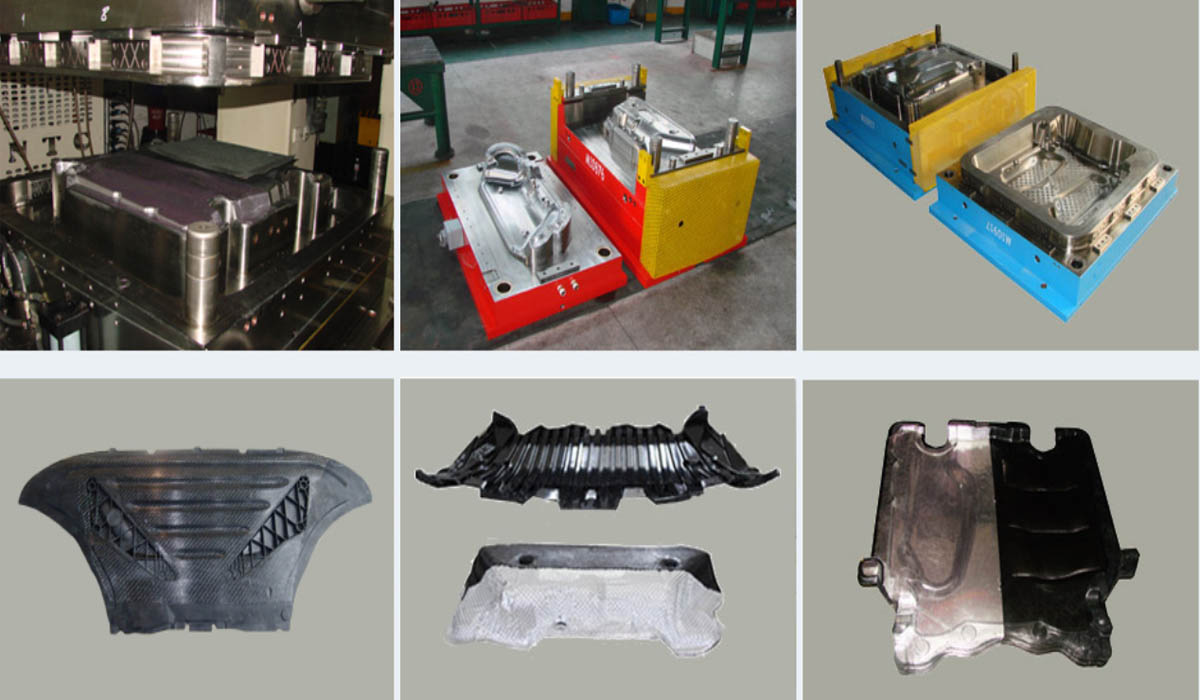Poor venting of the mold will bring a series of hazards to many aspects such as the quality of plastic parts. The main manifestations are as follows:

1. Improper equipment selection.
When using the selection equipment, the maximum injection volume of the injection molding machine must be greater than the total weight of the plastic part and nozzle, and the total injection weight cannot exceed 85% of the plasticization volume of the injection molding machine.
2. Insufficient material supply.
At present, the commonly used method of controlling the feeding is the fixed-volume feeding method, whether the amount of roll material is uniform with the fruit particle size of the raw material, and whether there is "bridging" phenomenon at the bottom of the feeding port. If the temperature at the feeding port is too high, it will also cause poor blanking. In this regard, the feeding port should be dredged and cooled.
3. The material has poor fluidity.
When the fluidity of the raw material is poor, the structural parameters of the mold are the main reason that affects the short injection. Therefore, the stagnation defects of the mold gating system should be improved, such as reasonable setting of the runner position, expansion of the gate, runner and injection port size, and the use of larger nozzles.
At the same time, an appropriate amount of additives can be added to the raw material formula to improve the fluidity of the resin. In addition, check whether the amount of recycled materials in the raw materials is excessive, and appropriately reduce the amount of recycled materials.
4. Excess lubricant.
If the amount of lubricant in the raw material formulation is too much, and the gap between the non-return ring of the injection screw and the barrel is large, serious reflux of the molten material in the barrel will cause insufficient supply and cause underfill. In this regard, the amount of lubricant should be reduced and the gap between the barrel, the injection screw and the non-return ring should be adjusted, and the equipment should be repaired.
5. The cold material impurity blocks the forehearth.
When impurities in the melt block the nozzle or cold material block
For the gate and runner, the nozzle should be folded down to clean or enlarge the mold cold slug and runner cross-section.
6. The design of the pouring system is unreasonable.
When a mold has multiple cavities, the appearance of the plastic part is often defective due to the unreasonable balance design of the gate and runner. When designing the gating system, pay attention to the balance of the gate. The weight of the plastic parts in each cavity should be proportional to the size of the gate, so that each cavity can be filled at the same time. The gate position should be selected at a thick wall, or a runner can be used. Design scheme for balanced layout. If the gate or runner is small, thin, and long, the pressure of the melt will lose too much along the way during the flow process, the flow will be blocked, and poor filling will easily occur. In this regard, the runner cross-section and gate area should be expanded, and multi-point feeding methods can be used if necessary.
7. Poor mold exhaust.
When a large amount of residual gas in the mold is squeezed by the flow material due to poor exhaust, and a high pressure greater than the injection pressure is generated, it will prevent the melt from filling the cavity and cause insufficient injection.
In this regard, it should be checked whether there is a cold slug hole or its position is correct. For a mold with a deep cavity, an vent groove or vent hole should be added at the undershot position; on the clamping surface, a depth can be opened For the exhaust slot with a width of 0.02~0.04mm and a width of 5~10mm, the exhaust hole should be set at the final filling position of the cavity. When using raw materials with excessive moisture and volatile content, a large amount of gas will also be generated, resulting in poor mold exhaust. At this time, the raw materials should be dried and volatiles removed.
In addition, in terms of the process operation of the mold system, the poor exhaust can be improved through auxiliary measures such as increasing the mold temperature, reducing the injection speed, reducing the flow assistance of the gating system, reducing the clamping force and increasing the mold gap.
8. The mold temperature is too low.
After the melt enters the low-temperature mold cavity, it will not be able to fill all corners of the cavity due to cooling too fast. Therefore, the mold must be preheated to the temperature required by the process before starting up. When starting up, the amount of cooling water in the mold should be appropriately controlled. If the mold temperature does not rise, check whether the design of the mold cooling system is reasonable
9. The temperature of the melt is too low
Generally, in the range suitable for molding, the material temperature and the filling length are close to a proportional relationship, and the flow performance of the low-temperature melt decreases, which shortens the filling length. When the material temperature is lower than the temperature required by the process, check whether the barrel feeder is intact and try to increase the barrel temperature.
When starting up, the temperature of the barrel is always lower than the temperature indicated by the indicator of the barrel heater. It should be noted that after the barrel is heated to the temperature of the indicator, it will take a period of time before the barrel can be turned on. If low-temperature injection is necessary to prevent the decomposition of the melt, the injection cycle time can be appropriately extended to overcome the lack of injection. For screw injection molding machines, the temperature of the front section of the barrel can be appropriately increased.
10 Nozzle temperature is too low
During the injection process, the nozzle is in contact with the mold. Since the mold temperature is generally lower than the nozzle temperature and the temperature difference is large, frequent contact between the two will cause the nozzle temperature to drop, causing the melt to freeze at the nozzle.
If there is no cold material cavity in the mold structure, the cold material will solidify immediately after entering the cavity, so that the hot melt blocked behind cannot fill the cavity. Therefore, the nozzle should be separated from the mold when opening the mold to reduce the influence of mold temperature on the nozzle temperature and keep the temperature at the nozzle within the range of the process requirements.
If the nozzle temperature is very low and cannot rise, check whether the nozzle heater is damaged, and try to increase the nozzle temperature, otherwise, the pressure loss of the flow material will be too large and it will cause insufficient injection.
11 Insufficient injection pressure or holding pressure
The injection pressure is close to the proportional relationship with the filling length. The injection pressure is too small, the filling length is short, and the cavity filling is not full. In this regard, the injection pressure can be increased by slowing down the injection advancement speed and appropriately extending the injection time.
In the case that the injection pressure cannot be further increased, it can be remedied by increasing the material temperature, reducing the melt viscosity, and improving the melt flow performance. It is worth noting that if the material temperature is too high, the melt will be thermally decomposed, which will affect the performance of the plastic parts.
In addition, if the holding time is too short, it will cause insufficient filling. Therefore, the pressure holding time should be controlled within an appropriate range, but it should be noted that too long a pressure holding time can also cause other failures. The molding should be adjusted according to the specific conditions of the plastic part.
12 Injection speed is too slow
The injection speed is directly related to the filling speed. If the injection speed is too slow, the melt will fill the mold slowly, and the low-speed flow of the melt will be easy to cool, causing its flow performance to further decrease and cause under-injection.
In this regard, the injection speed should be appropriately increased. But it should be noted that if the injection speed is too fast, it is easy to cause other molding failures.
13 Unreasonable structural design of plastic parts
When the thickness of the plastic part is not proportional to the length, the shape is very complicated and the forming area is large, the flow of the melt is easily blocked at the entrance of the thin-walled part of the plastic part, making it difficult to fill the cavity. Therefore, when designing the shape and structure of the plastic part, it should be noted that the thickness of the plastic part is related to the limit flow length of the melt when filling the mold.
In injection molding, the thickness of plastic parts is 1~3mm, and the thickness of large plastic parts is 3~6mm. Generally, the minimum thickness recommended is 0.5mm for polyethylene, 0.7mm for cellulose acetate and cellulose acetate butyrate plastics, Ethyl cellulose plastic 0.9mm, polymethyl methacrylate 0.7mm, polyamide 0.7mm, polystyrene 0.75mm, polyvinyl chloride 2.3mm. Generally, plastic parts with a thickness of more than 8mm or less than 0.5mm are unfavorable for injection molding, and such thickness should be avoided in the design.
In addition, when molding complex structural plastic parts, necessary measures must be taken in the process, such as reasonably determining the position of the gate, appropriately adjusting the runner layout, increasing the injection speed or adopting rapid injection. Increase the mold temperature or choose a resin with better fluidity.
MB/Wechat/Whatsapp:+0086-13456489912
sophiemould@foxmail.com


Post time: Sep-26-2021
